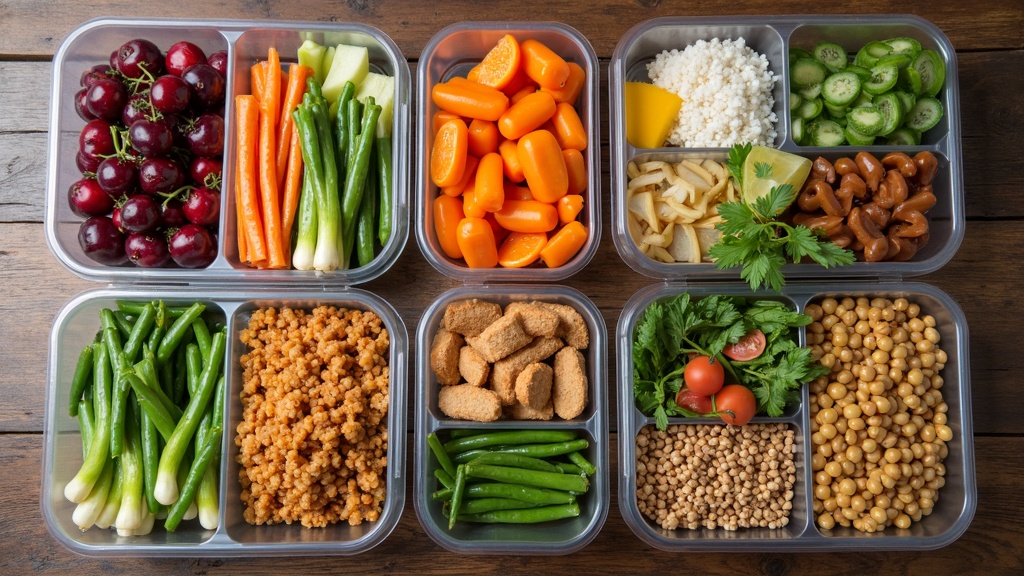Exploring plantbased frozen meals is an easy way to enjoy quick, flavorful, and nutritious food without spending hours in the kitchen.
Whether you’re aiming to eat less meat, follow a vegan diet, or just want wholesome dinner options, frozen meals in this category pack in a surprising amount of variety.
I’m sharing my experience with these freezer staples and what you need to know about finding yummy, plantpowered meals that fit your taste and lifestyle.

Getting to Know Plantbased Frozen Meals
The market for plantbased frozen meals has grown a ton in the last decade.
These days, there’s more than just tofu stirfrys and veggie burgers in the frozen aisle.
You’ll spot dishes inspired by global flavors, loaded grain bowls, meatfree pizzas, creamy pasta bakes, and even hearty stews, all made without animal products.
Major brands like Amy’s, Gardein, Sweet Earth, and Daiya are regulars in my local grocery stores, but there are also smaller, regional brands bringing some pretty cool food ideas to the table.
According to the Plant Based Foods Association, the plantbased food category keeps growing, with sales passing $7 billion in the U.S.
These meals appeal to longtime vegans as well as anyone who just wants something fresh and fast in the freezer.
The roots of plantbased frozen meals go back to the origins of frozen convenience foods in the mid20th century, but only in recent years have these options really taken off thanks to advances in food science, better knowledge of nutrition, and much more demand for meatless meals.
What I like most is how approachable these meals have become.
No complicated prep, no confusing labels, just practical options for busy days.
What to Expect from Plantbased Frozen Meals
For anyone new to this type of food, these meals cover a pretty wide spectrum.
Some are fully vegan, others are vegetarian, and a few may contain traces of dairy or eggs depending on the brand.
Most plantbased frozen meals use ingredients like vegetables, beans, lentils, chickpeas, grains, mushrooms, tofu, or plantbased protein blends.
They’re often seasoned with bold spices or sauces to punch up the flavor.
Here are a few types of dishes you’ll commonly see:
- Buddha Bowls: A combo of grains, veggies, beans, and a tasty sauce. Super filling and often nutrient dense.
- Vegan Pizzas: Topped with plantbased cheese (usually made from nuts, coconut, or soy) and stacked with veggies, sometimes with vegan sausage or pepperoni.
- Curries: Indian and Thaiinspired curries with coconut milk, lentils, potatoes, peas, and rice for a comforting, creamy meal.
- Pasta Dishes: Mac and cheese made with cashew or soybased sauces, meatless lasagnas packed with veggies and tofu ricotta, and Alfredo bowls that don’t skimp on creaminess.
- Stirfries: Lots of Asianstyle dishes with noodles or rice, crunchy vegetables, edamame, and soybased proteins.
Quick Guide: Picking a Good Plantbased Frozen Meal
Standing in front of the freezer case with dozens of options can feel a bit overwhelming at first.
I keep a few strategies in mind to pick meals that really deliver on taste, value, and nutrition:
- Check the Protein Content: I look for meals with at least 10 grams of protein, usually from beans, lentils, or soy. This helps keep things filling.
- Watch the Sodium: Frozen meals sometimes come with a load of sodium for flavor and preservation. I usually pick options under 600 mg if I’m eating them often.
- Scan the Ingredients List: The shorter and more familiar the list, the better for me. Whole veggies, grains, and spices near the top are a good sign.
- Try Different Global Flavors: I rotate between cuisines—Indian curries, Mexican enchiladas, and Asian bowls—so meals don’t get boring.
- Read Reviews: Sometimes I’ll check reviews online (like on Amazon or brand websites) to see what other shoppers say about texture, seasoning, and value.
Using these points helps me pick out meals that actually taste good and leave me satisfied, instead of disappointed.
Things You Should Probably Know Before Buying Plantbased Frozen Meals
There are a few things I’ve picked up that help make the most of these freezer finds, along with some quirks worth knowing.
- Texture Can Vary: Not every plantbased cheese or meat alternative will taste just like the real thing. Some options, especially cheezes made from coconut oil, can feel a bit different. Try several brands to find your favorite.
- Cooking Instructions Matter: I always check if the meal recommends oven baking instead of microwaving. The oven takes a bit longer but gives a better texture, especially for crispy coatings or cheese toppings.
- Portion Size: Some plantbased meals are smaller than you might expect, so I sometimes add a side salad, extra steamed rice, or roasted veggies to bulk it up.
- Added Sugars: A few meals, especially Asianinspired ones, can be a little heavyhanded on the sweetness. I check the nutrition label if I’m watching sugar intake.
Nutrition and Balanced Eating
Most plantbased frozen meals aim to cover multiple food groups, but not all meals are created equal.
I look for a good blend of protein, fiber, and healthy fats.
Many meals offer a pretty decent veggie count, but I’ll often toss in extra greens or top bowls with hemp seeds or avocado for more nutrients.
If you’re using these as a main food source, take time to rotate between highprotein, leafy green, and grainfocused dishes for variety.
Price Point and Accessibility
Plantbased frozen meals usually cost between $4 and $8 per entree, depending on the brand and portion size.
Sometimes, regional supermarket brands will offer lower prices with similar quality.
If you buy in bulk when items go on sale, it’s actually a pretty affordable way to eat plantbased, especially when compared to takeout or eating out.
Even oldschool grocery stores carry plantbased lines, and specialty retailers like Whole Foods and Sprouts have entire freezer doors full of options.
Advanced Tips and Meal Hacks
Once I got comfortable with basic plantbased frozen meals, I started trying some tricks to make them more filling, tastier, or just a little fancier.
Add Fresh Toppings: A handful of greens, diced herbs, toasted seeds, or a scoop of fresh guac can bring new life to almost any frozen bowl.
It’s especially nice for balancing out rich or salty flavors.
Custom Sides: If I want extra crunch, I serve curry or chili bowls with tortilla chips, or bake up a quick side of roasted broccoli or sweet potatoes.
MixandMatch: Sometimes, I’ll combine two meals, like adding buffalo cauliflower nuggets to a grain bowl, and drizzle with a favorite vegan sauce or dressing for a mashup dinner.
Homemade Sauces: A burst of sriracha, a spoonful of vegan ranch, or a quick tahini sauce can take up pretty much anything from the freezer.
Common Questions About Plantbased Frozen Meals
I get asked a lot about how these meals stack up compared to other quick plantbased options.
Here are a few things most folks want to know:
Question: Are plantbased frozen meals healthy?
Answer:
A lot of them are pretty balanced and can absolutely fit into a healthy routine.
Just keep an eye on sodium and ingredients, and toss in extra veggies if you want more fiber or nutrients.
Question: Do plantbased frozen meals taste good?
Answer:
Most taste great, and there’s a lot more flavor variety than even a few years ago.
That said, personal taste plays a big role and some brands nail it better than others.
Sampling a few toprated options is worth trying.
Question: Can these meals help with weight management?
Answer:
Because they’re often portioned and high in fiber from beans and grains, they can work well for people keeping an eye on calories.
Pairing meals with fresh veggies can help you feel fuller and stay satisfied longer.
Plantbased Frozen Meals in My Kitchen
I keep my freezer stocked with a variety of plantbased meals for busy days and lazy nights.
A few of my alltime favorites include Sweet Earth Curry Tiger bowls, Gardein Ultimate PlantBased Chick’n Tenders, and Amy’s Black Bean & Quinoa burritos.
I usually round out my meal with some fresh salsa, a side of greens, or a splash of hot sauce for variety.
Eating plantbased doesn’t mean sacrificing convenience or flavor.
With the array of options in most grocery store freezers, anyone, whether you’re a vegan, flexitarian, or just veggiecurious, can find meals that fit their vibe and routine.
Trying a few new dishes each month keeps things fresh and makes weeknight dinners way easier.
Over time, you might even find that these meals spark ideas and recipes for your own plantbased cooking at home.
So next time you pass the freezer aisle, don’t hesitate to grab a couple of new plantbased frozen meals to try out – your taste buds and schedule will thank you.

Being in my 60s now I am attempting to live healthier, I have started weight lifting, rowing, and cycling. Now I am interested in improving my diet, I would like to go to a plant-based diet from what I have read in your article.
Your frozen meal guide on what to look out for is very beneficial, I notice many of the frozen meals are extremely high in sodium. Great the you shared to go with meals under 600mg of sodium, with this information I can make much better choices than i would have on my own.
Your common questions and answers are a great addition to this article, you answered all of my own question plus more
Great article,
Jeff
This was such an informative and enjoyable read! I really appreciate how you highlighted not only the wide variety of plant-based frozen meals available today but also the practical tips for choosing the better ones like keeping an eye on protein, sodium, and ingredients. The suggestions for adding fresh toppings or pairing with simple sides really make these meals feel more balanced and exciting.
I’ve always seen frozen meals as a bit of a fallback, but your post makes me realise they can actually be a smart and convenient option, especially when you know what to look for. I’m definitely inspired to try out a few new brands and experiment with adding my own fresh touches to make them feel more homemade. Thanks for sharing such thoughtful info.
Do you have a personal favourite brand or go-to frozen meal that you keep stocked at home?
“Love that question! I do keep a couple of frozen plant-based meals around for those days when I’m too busy to cook. Amy’s Kitchen bowls and Sweet Earth’s global-inspired meals are two of my go-to’s — they’re quick, tasty, and feel like real food rather than just ‘convenience food.’ Trader Joe’s has some fun options too if you’re near one (their vegan tikka masala is a favorite).
Thank you for your wonderful comments!